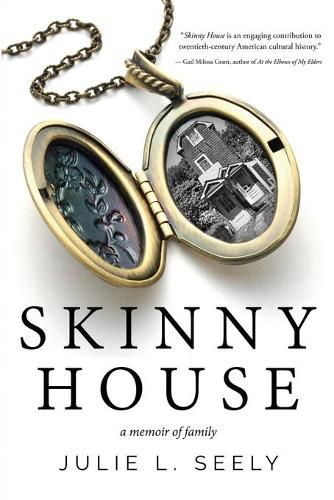Readings Newsletter
Become a Readings Member to make your shopping experience even easier.
Sign in or sign up for free!
You’re not far away from qualifying for FREE standard shipping within Australia
You’ve qualified for FREE standard shipping within Australia
The cart is loading…






This title is printed to order. This book may have been self-published. If so, we cannot guarantee the quality of the content. In the main most books will have gone through the editing process however some may not. We therefore suggest that you be aware of this before ordering this book. If in doubt check either the author or publisher’s details as we are unable to accept any returns unless they are faulty. Please contact us if you have any questions.
Skinny House-A Memoir of Family is a story of perseverance in the face of ruin and a glimpse into the past of the inventive, remarkable people who gracefully ‘made it’ despite overwhelming societal and financial hurdles. It is a granddaughter’s story about the grandfather she never met. After digging through boxes of family memorabilia, the author weaves the legacy of Nathan Seely, one of the first African American homebuilders in Westchester County, New York. Nathan, an ambitious carpenter, establishes the Seely Bros. Construction Company in 1923 for the purpose of building homes for colored people. He has everything a man could want…a beautiful wife, smart children and a custom-built house in the Village of Mamaroneck, along the picturesque Long Island Sound.
Nathan’s success is short lived when The Great Depression roars through America, leaving him bankrupt and threatening to make his family homeless. Desperate to keep his family together, Nathan has to come up with a plan to rebuild his life. He will have to do it, literally, brick by brick.
Nathan’s 10-ft-wide, 3-story skinny home, built in 1932, still stands in Mamaroneck. Newspaper articles have focused on the architectural details of the famous house or the donated land upon which it is built, however the intimate story about the family who lived in the house has never been told. The author poses some intriguing questions for all of us. What do we really know about the lives, dreams and aspirations of our ancestors? How do the decisions our grandparents and parents made influence our lives? What are our roles as legacy makers?
$9.00 standard shipping within Australia
FREE standard shipping within Australia for orders over $100.00
Express & International shipping calculated at checkout
This title is printed to order. This book may have been self-published. If so, we cannot guarantee the quality of the content. In the main most books will have gone through the editing process however some may not. We therefore suggest that you be aware of this before ordering this book. If in doubt check either the author or publisher’s details as we are unable to accept any returns unless they are faulty. Please contact us if you have any questions.
Skinny House-A Memoir of Family is a story of perseverance in the face of ruin and a glimpse into the past of the inventive, remarkable people who gracefully ‘made it’ despite overwhelming societal and financial hurdles. It is a granddaughter’s story about the grandfather she never met. After digging through boxes of family memorabilia, the author weaves the legacy of Nathan Seely, one of the first African American homebuilders in Westchester County, New York. Nathan, an ambitious carpenter, establishes the Seely Bros. Construction Company in 1923 for the purpose of building homes for colored people. He has everything a man could want…a beautiful wife, smart children and a custom-built house in the Village of Mamaroneck, along the picturesque Long Island Sound.
Nathan’s success is short lived when The Great Depression roars through America, leaving him bankrupt and threatening to make his family homeless. Desperate to keep his family together, Nathan has to come up with a plan to rebuild his life. He will have to do it, literally, brick by brick.
Nathan’s 10-ft-wide, 3-story skinny home, built in 1932, still stands in Mamaroneck. Newspaper articles have focused on the architectural details of the famous house or the donated land upon which it is built, however the intimate story about the family who lived in the house has never been told. The author poses some intriguing questions for all of us. What do we really know about the lives, dreams and aspirations of our ancestors? How do the decisions our grandparents and parents made influence our lives? What are our roles as legacy makers?